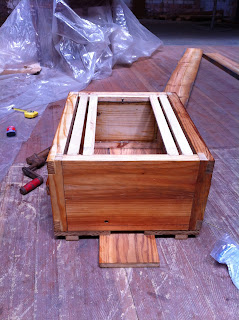Since our April post much has happened at the DHC. Shortly after the last post we completed our brick paver path, and began stock piling materials to build our raised beds.
After we completed the brick paver path, we began to stockpile broken concrete and compost, which can be seen here.
Building our tiered raised beds involved moving the massive amount of earth which was originally excavated from our amphitheater hole. This earth was used to fill in a large depression in a lot adjacent to us, the result of a demolition cap that had settled over time. We are planning to turn the filled hole into a grain patch in the coming weeks. A similar sink hole existed across the street and was threatening to destabilize our neighbor's house. He took a large amount of earth to fill in his hole as well.
Simeon talking animatedly, as our neighbor Kelly moves dirt excavated from our future amphitheater. We moved about fifty cubic yards of earth in order to prepare our raised beds.
Moving the broken concrete blocks was no walk in the park. Moving 20 – 80 pound objects for several hours was back breaking work, especially during the unseasonably hot weather we had in mid to late May. There was certainly something satisfying about fitting the blocks together though.
Here are the tiered raised beds before putting the front wall on. Half of them have been tilled with compost and fertilizer (manure). In the background is the crushed limestone which will eventually be used for the floor of the amphitheater.
On May 13th we started Volunteer Days, our weekly garden volunteer meeting. We have had about 10 volunteers come out and help us so far. Thanks to Greg Baise, Matt Lambert and Chloe, Alissa Lamarre, Jesse Soltis, Bryan Baker and Carrie Walker who have all helped out.
Alissa Lamarre, our May Volunteer of the month, helped us construct a bed adjacent to our brick paver path. Note the curved concrete pieces she used around our potted sage. Nice touch. The bed now has red cabbage, chinese eggplant, thai basil and four varieties of peppers.
Now that the crops are in for the most part we have been turning our attention back to the amphitheater and other infrastructure projects. Our water catchment system will be a sub-layer underneath the amphitheater floor and so we are now grading the hole and digging a trench for the plumbing. Any water that falls into the amphitheater basin will run off into a pipe, then two holding tanks, which will be connected to a hand pump, from which we can draw water for the garden. There is still about ten hours worth of earth moving and grading to do before we can put in the plumbing, but we are getting close!
After all the hard labor building the concrete planter boxes, we were able to plant 48 tomato seedlings the last week in May.
So far the real pay off has been seeing the crops take off. The tomato seeds we saved from last season seem to be performing extremely well as they have adapted to the climate here (about 6 varieties), but the other 14 varieties of heirloom tomato seeds we ordered seem to be doing just fine.
Chard is a biennial, which takes two years to flower and produce seed and our 2nd year rainbow and swiss chard are flowering. We plan to take seeds from them which will likely be cross pollinated between the two varieties. We'll let you know next year what the resulting variety looks and tastes like. The strawberry patch is bearing fruit, but in all likelihood will do much better next year as the plants suffered quite a bit of transplant shock in the May heatwave.
The payoff: A Beam's Yellow Pear already has fruit growing. Tomato season is upon us!
We would be remiss not to mention the incredible progress of our apiary, but we are going to dedicate an entirely separate post to the bees.
We hope to see you down at the DHC on Sunday.
More soon,
-The DHC Crew



























